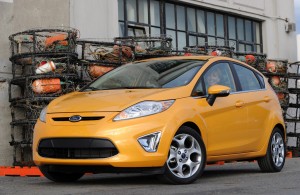
Though they worked together on the underlying platform, Ford and Mazda have drifted apart since beginning work on the Fiesta and Mazda3 models.
Ford Motor Co. will sharply reduce its once commanding stake in Japanese automaker Mazda, reflecting the continuing shift in focus by the American automaker towards its core “Blue Oval” Ford brand.
Despite the cutback, which means Ford will no longer be Mazda’s single-largest shareholder, the two makers insist little will actually change in their decades-long relationship.
Ford will generate $370 million by reducing its stake in Mazda from the current 11% to just 3.5% in a deal completed today. (TheDetroitBureau.com had originally reported on the planned sale last month.)
It’s a sharp shift in their long-standing ties, which date back to the 1970s, when Mazda began supplying Ford with transmissions. By 1979, as the Japanese maker struggled to deal with ongoing financial problems, Ford expanded its stake to the point it became Mazda’s largest shareholder. The stake eventually grew to 33.4% which, under Japanese law, put Ford into a position to name its own management team.
Mark Fields, currently Ford President of the Americas, served a term as Ford’s point man in charge of Mazda before making a series of moves that eventually landed him back at the U.S. maker’s suburban Detroit headquarters.
But things began to shift with the arrival, four years ago, of Alan Mulally, the former Boeing executive named CEO of Ford. Mulally quickly put into place the “One Ford” strategy, which de-emphasized the maker’s overseas brands, such as Volvo and Jaguar, which were eventually sold off. He also reduced Ford’s stake, in late 2008, to 13%.
Mazda insiders say that move was not unwelcome. Mazda has been increasingly focused on regaining control of its own destiny, though it did continue working on projects with Ford. The two have jointly developed a number of vehicles, over the years, starting with a version of the old Escort subcompact and, more recently, the platform that went on to serve as the foundation for both the latest Mazda3 and the global Ford Fiesta subcompact.
Nonetheless, Derrick Kuzak, Ford’s global engineering chief, recently told TheDetroitBureau.com that “Ford is more than capable of doing things on its own” in product segments that once involved Mazda’s engineering prowess.
Mazda itself has been looking elsewhere, forming a relationship with Toyota in the area of hybrid-electric technology.
Jim O’Sullivan, Mazda’s top American executive, told TheDetroitBureau.com that he doesn’t foresee any changes in the way the two companies have worked together in recent years. But whether that means they will participate on future joint product development programs seems questionable, sources said.
Where they may stay teamed up is in global manufacturing. Mazda produces its Mazda6 sedan at a factory run in cooperation with Ford in the Detroit suburb of Flat Rock. And they operate an assembly plant near Bangkok that services much of Asia. It recently launched a new midsize pickup Ford sells as the Ranger.
But Mazda has asked Chinese authorities to pull out of a joint manufacturing operation with Ford in that fast-growing Asian market.
